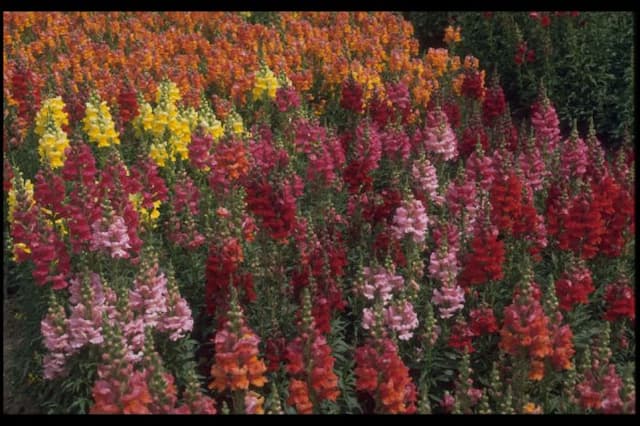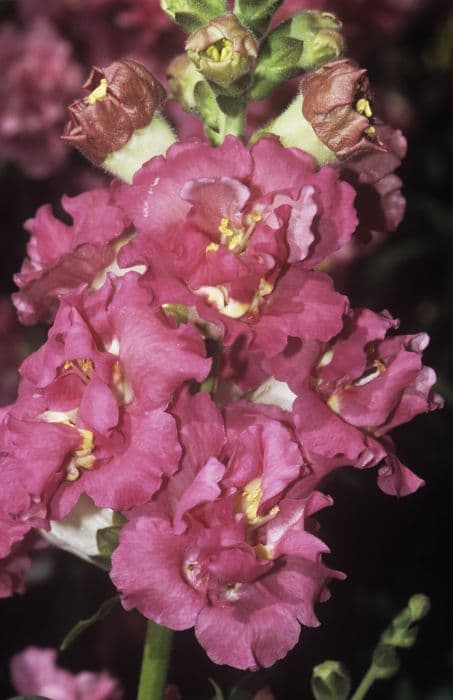Penstemon 'Margery Fish' Penstemon 'Margery Fish'

ABOUT
'Margery Fish' is a spreading semi-evergreen perennial to 50cm in height, with narrow, slightly glossy leaves and slender, dense panicles of purple-tinged, pale blue flowers 3cm in length
About this plant
 Names
NamesFamily
Plantaginaceae
Synonyms
Beardtongue, Beard Tongue
Common names
Penstemon 'Margery Fish'.
 Characteristics
CharacteristicsLife cycle
Perennials
Foliage type
Deciduous
Color of leaves
Green
Flower color
Pink
Height
2 feet (60 cm)
Spread
2 feet (60 cm)
Plant type
Herb
Hardiness zones
3
Native area
North America
Benefits
 General Benefits
General Benefits- Attracts Pollinators: The Penstemon 'Margery Fish', commonly known as Beardtongue, produces flowers that attract bees, butterflies, and hummingbirds, helping to pollinate your garden.
- Drought Tolerance: Once established, Beardtongue is drought-resistant, making it ideal for xeriscaping and low-water gardens.
- Low Maintenance: Beardtongue generally requires minimal care, thriving in well-drained soil with little need for fertilization or pruning.
- Long Blooming Season: It has a lengthy blooming period, often from late spring to early fall, providing long-lasting color and interest in the garden.
- Deer and Rabbit Resistance: Beardtongue is not a preferred food source for deer and rabbits, making it an excellent choice for areas with wildlife pressure.
- Versatility: It can be utilized in various landscape designs, including borders, rock gardens, and wildflower meadows.
- Color Variety: Penstemon 'Margery Fish' offers lovely pink to purple flowers, adding a splash of color to your garden palette.
- Soil Adaptability: It can adapt to a wide range of soil conditions, although it prefers well-drained soils.
 Medical Properties
Medical PropertiesThis plant is not used for medical purposes.
 Air-purifying Qualities
Air-purifying QualitiesThis plant is not specifically known for air purifying qualities.
 Other Uses
Other Uses- Art and Craft: The colorful flowers of Penstemon can be used in dried flower arrangements for decorative purposes.
- Ink Production: The deep hues of Penstemon flowers may be utilized in natural ink or dye production for art or fabric coloring.
- Education: Penstemon species can be used in botanical studies to educate on plant morphology and pollinator interactions.
- Garden Design: Penstemon 'Margery Fish' is often used for cottage garden design, providing a traditional and informal aesthetic.
- Edible Garnish: Although not commonly consumed, the flowers can potentially be used as a colorful, edible garnish in salads.
- Photography: With its striking flowers, Penstemon is a popular subject for garden and nature photographers.
- Soil Stabilization: The Penstemon's root system can help in stabilizing soil and preventing erosion on slopes.
- Wildlife Shelter: The dense foliage of the Penstemon provides shelter for small wildlife and beneficial insects.
- Cultural Symbolism: In some cultures, the Penstemon flower may represent a particular symbolism and thus be used in cultural ceremonies.
- Seed Exchange: Gardeners and horticultural societies often use seeds of Penstemon for seed swap events to share and promote diversity in gardens.
Interesting Facts
 Feng Shui
Feng ShuiThe Beardtongue is not used in Feng Shui practice.
 Zodiac Sign Compitability
Zodiac Sign CompitabilityThe Beardtongue is not used in astrology practice.
 Plant Symbolism
Plant Symbolism- Endurance: Penstemons, including the 'Margery Fish' variety, are resilient plants that are known for their ability to withstand challenging conditions, symbolically representing the human trait of enduring difficult times.
- Health: Traditionally, some Penstemon species were used by indigenous peoples for medicinal purposes, and thus it can symbolize the wish for good health or healing.
- Attractiveness: With its striking flowers, the 'Margery Fish' penstemon adds beauty to any garden, symbolizing aesthetic appeal and the enjoyment of life's pleasures.
- Diversity: Penstemons come in a wide variety of colors and forms, reflecting the importance and beauty of diversity in nature and in human cultures.
- Balance: The 'Margery Fish' penstemon can thrive in diverse environments, which may symbolize balance and adaptability in life's various circumstances.
 Water
WaterBeardtongue should be watered deeply once a week, providing about an inch of water during each session. To avoid soggy conditions, let the soil dry out between waterings. During hot, dry spells, you may need to water twice a week, while in cooler, wetter seasons, you can reduce watering frequency. Always check the top few inches of soil for moisture before watering again. It's best to water early in the morning or late in the afternoon to reduce evaporation.
 Light
LightBeardtongue thrives in full sun, which means it needs at least 6-8 hours of direct sunlight per day. However, it can tolerate some partial shade, especially in hotter climates where it may benefit from protection from the scorching midday sun. An ideal spot would be one that receives morning sunshine and some afternoon shade or dappled light throughout the day.
 Temperature
TemperatureBeardtongue is hardy and can withstand a range of temperatures, being most comfortable between 60 and 75 degrees Fahrenheit. It can survive minimum temperatures down to about 20 degrees Fahrenheit, but it is important to protect it from frost. During the hottest parts of the summer, Beardtongue can tolerate temperatures well into the 80s and 90s as long as it's well-watered.
 Pruning
PruningPrune Beardtongue to maintain its shape and encourage bushier growth and more flowers. Deadheading spent blooms will promote further flowering. Prune back heavily in late fall or early spring to help rejuvenate the plant for the coming season. Pruning is typically done once a year, but deadheading can be done regularly throughout the blooming season.
 Cleaning
CleaningAs needed
 Soil
SoilThe Beardtongue prefers well-draining soil with a gritty or sandy composition, high in organic matter, and a slightly acidic to neutral pH between 6.0 to 7.0. A mix incorporating sand and compost works well to ensure good drainage and fertility.
 Repotting
RepottingBeardtongues generally do not require frequent repotting and can be repotted every 2-3 years or when the root system outgrows the container. Choose spring or early summer for repotting.
 Humidity & Misting
Humidity & MistingBeardtongue prefers average to low humidity conditions and does not require high humidity levels, making it suitable for typical outdoor environments.
 Suitable locations
Suitable locationsIndoor
Provide sun by a window & well-draining soil mix.
Outdoor
Plant in sunny spot, well-draining soil, protect from extreme cold.
Hardiness zone
3-8 USDA
 Life cycle
Life cycleThe life of the Beardtongue 'Margery Fish' begins with seed germination, which occurs in warm, moist soil conditions typically in spring. Once germinated, the seedling develops a root system and foliage in its growth phase, thriving in well-draining soil with plenty of sunlight. As a perennial, it enters a mature phase, producing tall stalks with tubular flowers that are attractive to pollinators, usually in late spring to early summer. After pollination, the flowers develop into seed capsules, which then release seeds, completing the reproductive cycle. The plant dies back to the ground in the winter, undergoing a period of dormancy, with the root system surviving to sprout again the following spring. Throughout its life, Beardtongue 'Margery Fish' may also spread through clonal propagation, forming new plants from its root system.
 Propogation
PropogationPropogation time
Spring-Summer
The ideal propagation time for the Beardtongue 'Margery Fish' is during late spring to early summer. The most popular and successful method of propagation for this plant is by basal cuttings. As the new growth starts to appear at the base of the plant, healthy non-flowering shoots about 2 to 3 inches (approximately 5 to 7.5 centimeters) long are selected. These cuttings are carefully removed with a sharp knife, ensuring each has a small piece of the parent plant's base, or 'heel,' attached. The cuttings are then planted in a mix of potting soil and perlite or sand to ensure good drainage. They should be placed in a warm, well-lit spot but out of direct sunlight until they root, which typically takes a few weeks. Once rooted, they can be transplanted into larger pots or directly into the garden.





![Snapdragon [Pretty in Pink]](/_next/image?url=https%3A%2F%2Fplants-admin.emdemapps.com%2Fimages%2Fplants%2F%2Fimages%2F604b5cb3b5385.png&w=640&q=75)



